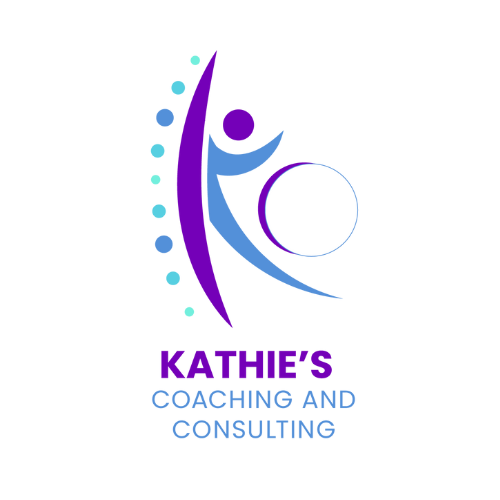Mastering Work-Life Balance: A Guide to Setting Boundaries in the Workplace
Today, we're delving into a topic that's essential for professionals in every industry: work-life balance. As a corporate wellness director, I've had the privilege of witnessing firsthand the transformative power of achieving balance and setting boundaries in the workplace. In this post, I'll share practical insights and strategies to help you navigate this journey successfully.
Listen to today’s episode on Kathie’s Coaching Podcast is here!
Statistics Show Us:
Productivity Impact: Employees who feel they have a good work-life balance are 21% more productive (Oxford Economics).
Burnout Concerns: 76% of employees experience burnout, with over half citing workload as the main cause (Gallup).
Impact on Health: 66% of employees report that job-related stress negatively impacts their personal relationships (APA).
Understanding Work-Life Balance:
Let's start by clarifying what work-life balance truly means. Contrary to popular belief, it's not about perfectly dividing your time between work and personal life. Instead, it's about finding harmony between the two—a delicate equilibrium that allows you to excel professionally while also nurturing your personal well-being.
Setting Boundaries in the Workplace:
One of the keys to achieving work-life balance is setting boundaries in the workplace. Here are some actionable tips to help you establish and maintain those boundaries:
Open Communication: Be transparent with your colleagues and supervisors about your availability outside of working hours. Clearly communicate your boundaries and preferences regarding after-hours communication.
Realistic Expectations: Set realistic expectations for yourself and others. Avoid overcommitting to tasks that exceed your capacity, and don't be afraid to delegate when necessary.
Learning to Say No: It's okay to decline additional work or projects if you're already stretched thin. Prioritize tasks based on importance and urgency, and remember that it's better to do a few things well than to spread yourself too thin.
Designating "Off" Hours: Set specific times during the day when you disconnect from work-related communication channels. Use this time to recharge and focus on activities that bring you joy and relaxation.
Technology Management: Use technology wisely to support your boundaries. Turn off notifications during non-working hours, and resist the temptation to check your email or messages incessantly.
Physical Boundaries: Create a dedicated workspace where you can focus on work-related tasks. Once you leave that space, mentally transition into personal time and engage in activities that replenish your energy.
Benefits of Work-Life Balance:
Now that we've explored strategies for achieving balance, let's take a look at some of the benefits:
Increased Productivity: When you prioritize self-care and set clear boundaries, you'll find that you're more focused and productive during working hours.
Enhanced Job Satisfaction: Achieving work-life balance leads to greater job satisfaction and overall well-being. You'll feel more fulfilled both professionally and personally.
Reduced Burnout: By managing your workload and respecting your boundaries, you'll reduce the risk of burnout and prevent long-term stress-related health issues.
Improved Mental Health: Work-life balance is essential for maintaining mental health. Taking time for yourself and engaging in activities you enjoy will help reduce stress and promote overall happiness.
Bonus Resources:
To further support you on your journey to work-life balance, here are some additional resources you may find helpful:
Book Recommendation: "The 4-Hour Workweek" by Timothy Ferriss offers valuable insights into maximizing productivity and achieving work-life balance.
Podcast Episode: Listen to "The WorkLife with Adam Grant" podcast for fascinating discussions on work, psychology, and how to thrive in both professional and personal domains.
Watch today’s video here!
Listen to the episode here!
Conclusion
In conclusion, work-life balance is not a one-size-fits-all concept. It's about finding what works best for you and making intentional choices to prioritize your well-being. By setting boundaries, managing your time effectively, and nurturing your personal life, you can achieve harmony between your professional responsibilities and personal fulfillment. Remember, it's not about perfection—it's about progress and prioritizing what truly matters in life.
Read More Articles Here
Transcript:
Today, we're diving into a topic that is important for all of us. It is work life balance, and how to start incorporating boundaries to protect yourself. So a boundary, I like to think of it like this. 📍 You're protecting your kingdom. That's all of this. And you're protecting that with boundaries. Boundaries can be like an invisible fence around you and how to protect yourself from that. Why do we need that?
We need that to prevent burnout. We needed to prevent. Unproductive behaviors and to get more effective at what we're trying to accomplish. And we're going to talk about that today.
Employees who feel like they have a good work-life balance are 21% more productive than the ones who feel like they don't.
Okay. If you don't have a work-life balance, the Gallup poll shows that 76% of employees who feel like their workload is too much 📍 experience burnout. Then there's the. The expense of your health and the APA shows that 66% of people experience. a, health issue because they do not have work-life balance. Let's talk about that today.
Let's start by clarifying what work-life balance is. You know, contrary to popular belief. It's not just a balance between work and your personal life. No, it's more like an equilibrium that goes on in between each so we can prevent burnout. So we can prevent procrastination so we can be more productive.
You want to Excel professionally and nurture your personal life at the same time.
So how do we do that? Well, today we're going to talk about boundaries and how they can help you.
You're listening to Kathie's coaching podcast. I'm your host, Kathie Owen.
Welcome to my YouTube channel. My name is Kathie Owen.
One of the key ways to achieving a healthy work-life balance is setting boundaries.
And I'm going to give you some key indicators right now on how you could start setting boundaries today.
📍 Number one open communication, be transparent with your coworkers and your supervisors. On your time that you're going to be putting into the work.
Clearly communicate your preferences on work hours and what's going to happen after work hours clearly communicate them. That's boundary. Number one.
📍 Number two set, realistic expectations. Avoid over committing to tasks that exceed your capacity. Yeah, we all have a 📍 limited capacity to what we can handle. And I'm a firm believer in finding flow as your way of being, and putting it as a priority. Flow state is what an athlete experiences when they're just in the zone, it's being in the zone. And once you get out of that zone, it affects your productivity. It affects your work-life balance and it's important to make flow a priority. I have a free course on flow. I'll have a link to it in the show notes and description below. But what happens when you're in flow?
When you feel like you had something that happened, that's a flow breaker. You draw a boundary around it. You get up, you walk away, you do something different for a little bit and then come back and everything looks completely different. For example, I am been missing for my YouTube. I had so many different issues come up that affected my work-life balance. My videos 📍 I'd record them in descript and they wouldn't come out. They would just be a mess. And I was having all of these bug issues inside of descript that was affecting my performance.
And I just finally just said, look, just take a break. Just don't do it. And it's been the longest time I've taken a real. Solid break probably since January of this year. And it's now April. I would say 📍 quarter one was a mess because everything was not working out. That was not flow. I would step away.
I would get frustrated. I would step away and that's called a flow breaker. I took my time and did something that was more productive for me, but my YouTube channel and my content creation was not up to par, but that's going to change now. Thank goodness. I got all that fixed. But I do have recording stress disorder.
I call it because I would be recording a video and go, I don't know if this is recording. I wouldn't tell you that. And it didn't record or something was buggy and it was just a mess. And I'm like, Oh, well, just chalk it up to experience, but that was a boundary that I drew I just got up. I was kind to myself and let it go.
📍 Learning to say no. Should you say no to certain projects? Absolutely. If you don't have the capacity to do it, You say no, but you've got to have that boundary of no. So that you can say yes to the things that are more prioritized and more important. Yes.
And no.
📍 Designating off hours. Personally, I could work all the time. I there's always something I could be doing inside of my business. But I've decided it's not fair to my friends and family to not give myself off hours or take time off when I want to spend time with family or do something. Outside of work. That's a boundary that I had to learn to set with myself. And then when I did that, that's going to prevent burnout and over fatigue in doing too much.
And it gets you out of flow. You could put yourself in flow by doing those off hour things and having good time and enjoying yourself.
📍 Technology management. This one is something I'm going to be talking about a lot more frequently because this one can be very challenging because we are addicted to our cell phones. We're addicted to technology that can bring us more things and more things and more things. Fortunately, I'm old enough to remember a time when we didn't have all of these technologies.
And I use that to my advantage. I can pull away from it. Put it away, put it down, let it go. And I'm going to be talking about this a lot more on my channel because technology management is something that can affect your productivity. And make it. Overstimulating overwhelming. Over burnout. It happens in real life.
📍 And then there's such thing as physical boundaries.
What does that mean? That means a designated workspace. For example, don't take your laptop to bed. That's not a good idea. Unless, this is just where you're just most productive. That's your workspace. But when you set a designated workspace, a physical boundary to where you do your work. You will find you'll be more productive.
You'll be able to find flow. And you'll also be able to have that boundary where, oh, okay. My brain goes, I'm not at my desk. I'm not needing to work right now and give yourself that break to avoid that burnout. So that's a physical boundary.
All right. There are some benefits to work, life balance and boundaries.
Let's talk about those. You've already heard me talk about this. 📍 Number one, you have increased productivity.
When you prioritize self care and your boundaries, you find you have, Better productivity. For example, I've been a personal trainer for many, many years. And I often found that people that I coach or train have difficulty finding that balance in between their exercise and their rest days. They have struggled with that so long that they've had so many rest days that they can't give themselves that when they start getting back into the routine, they think that that doesn't come in there. But I also tell them you got to prioritize self care.
You've got to prioritize your rest days. And sometimes that takes discipline, putting it into your calendar, your workout days and your rest days. That is self-care. It helps enhance your productivity in your workouts. Just work much better because you're not over-training. And same thing with your not. Overstimulating your nervous system by taking on too much.
📍 You'll have reduced burnout. So. Burnout is going to happen if you're doing too too much and you don't have it in balance and you're not in flow. So by reducing burnout, you're going to have better productivity and you're going to have less stress-related health concerns. That is. Just another one of the benefits of having a work-life balance and boundaries in the same place. Reduced burnout.
📍 Improved mental health.
So I think it was Charles Darwin that had this. Thing he called a 📍 walk. He would take a nature walk. He had, what's called the nature walk and he would go take a walk in nature and his ideas would just come to him, come to him. And you may have noticed this in your life when you're not looking at technology, when you are out in nature.
Most people tell me I had the most best ideas while I was in the shower. Why? Because you're not thinking about anything else. You don't have any stimulation coming. In to the brain. And you're not, you're setting that boundary by protecting yourself. And taking that walk in nature. That's one thing I enjoy doing, especially when the weather is really nice. It's just take a break. So I like taking rusty to work with me because what we'll do is he's always got to go outside.
And when the weather's really nice, he really wants to go outside. So I take him for a walk and then we just go outside. Take a chill pill. And next thing I know, I come back to my desk with an improved mental health, mental mindset that changes everything. And a lot of times that's when my Epiphanes will come.
I'll be like, Oh, yeah, I got to do that and I've got to do this and they just flow. Flow. Like nature.
So have some bonus resources as always. And one of them is the book, 📍 The Four Hour Work Week by Tim Ferriss. And you've probably heard of this. Now. I don't necessarily agree that it's just a four hour work week, but I do believe it is in finding flow and getting flow a priority. It just makes everything come together and makes everything work better.
And that's pretty much the premise of that book is that it just works. It just works. And it feels like fun. It doesn't feel like work. And then there's a podcast that I also highly encourage you to enjoy.
That's the work-life balance with Adam Grant. So this podcast has fascinating topics on psychology. Yeah. I geek out on that kind of stuff. And also how to thrive in professional and personal. Environments, how to thrive in those. He gives great tips and ideas and suggestions in this podcast.
So in conclusion work life balance is not just about. A one-size fits all. It's like personal training. There's not a one size fits all program to fit this. But it's about finding what works for you. What gets you into flow state? What makes you most productive?
By setting boundaries and managing your time effectively, you will find. That flow.
You will find that harmony between your professional responsibilities and your personal life. That is work-life balance. Again, it's not a one size fits all, but it does help enhance that. All right. That's my episode for today. I trust that you found it helpful. If you know someone who could benefit from it, please share it with them.
And until next time I will see you next time. Peace out. And Namaste. Bing!














A leadership coach shares her personal journey of being fired for speaking up against toxic workplace culture, drawing parallels with Ted Lasso's themes of authentic leadership and courage. Her story illustrates how challenging systemic dysfunction often comes at a cost—but leads to greater freedom. #WorkplaceCulture #Leadership #TedLasso #ToxicWorkplace #CareerGrowth